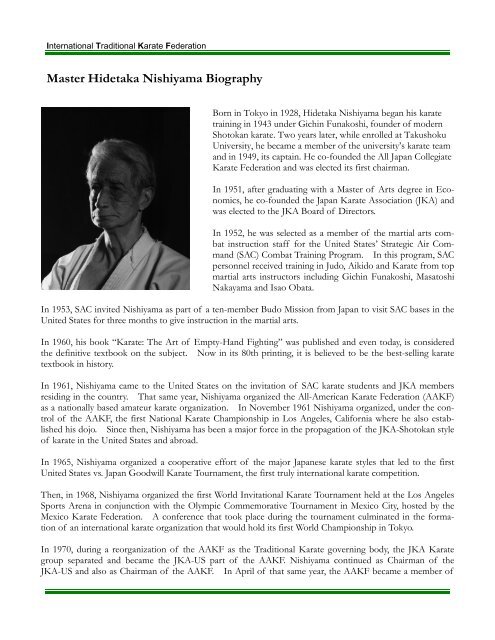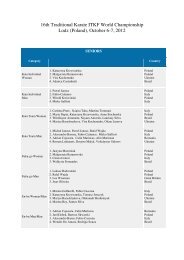Hidetaka Nishiyama Biography .pdf - International Traditional Karate ...
Hidetaka Nishiyama Biography .pdf - International Traditional Karate ...
Hidetaka Nishiyama Biography .pdf - International Traditional Karate ...
You also want an ePaper? Increase the reach of your titles
YUMPU automatically turns print PDFs into web optimized ePapers that Google loves.
<strong>International</strong> <strong>Traditional</strong> <strong>Karate</strong> Federation<br />
Master <strong>Hidetaka</strong> <strong>Nishiyama</strong> <strong>Biography</strong><br />
Born in Tokyo in 1928, <strong>Hidetaka</strong> <strong>Nishiyama</strong> began his karate<br />
training in 1943 under Gichin Funakoshi, founder of modern<br />
Shotokan karate. Two years later, while enrolled at Takushoku<br />
University, he became a member of the university’s karate team<br />
and in 1949, its captain. He co-founded the All Japan Collegiate<br />
<strong>Karate</strong> Federation and was elected its first chairman.<br />
In 1951, after graduating with a Master of Arts degree in Economics,<br />
he co-founded the Japan <strong>Karate</strong> Association (JKA) and<br />
was elected to the JKA Board of Directors.<br />
In 1952, he was selected as a member of the martial arts combat<br />
instruction staff for the United States’ Strategic Air Command<br />
(SAC) Combat Training Program. In this program, SAC<br />
personnel received training in Judo, Aikido and <strong>Karate</strong> from top<br />
martial arts instructors including Gichin Funakoshi, Masatoshi<br />
Nakayama and Isao Obata.<br />
In 1953, SAC invited <strong>Nishiyama</strong> as part of a ten-member Budo Mission from Japan to visit SAC bases in the<br />
United States for three months to give instruction in the martial arts.<br />
In 1960, his book “<strong>Karate</strong>: The Art of Empty-Hand Fighting” was published and even today, is considered<br />
the definitive textbook on the subject. Now in its 80th printing, it is believed to be the best-selling karate<br />
textbook in history.<br />
In 1961, <strong>Nishiyama</strong> came to the United States on the invitation of SAC karate students and JKA members<br />
residing in the country. That same year, <strong>Nishiyama</strong> organized the All-American <strong>Karate</strong> Federation (AAKF)<br />
as a nationally based amateur karate organization. In November 1961 <strong>Nishiyama</strong> organized, under the control<br />
of the AAKF, the first National <strong>Karate</strong> Championship in Los Angeles, California where he also established<br />
his dojo. Since then, <strong>Nishiyama</strong> has been a major force in the propagation of the JKA-Shotokan style<br />
of karate in the United States and abroad.<br />
In 1965, <strong>Nishiyama</strong> organized a cooperative effort of the major Japanese karate styles that led to the first<br />
United States vs. Japan Goodwill <strong>Karate</strong> Tournament, the first truly international karate competition.<br />
Then, in 1968, <strong>Nishiyama</strong> organized the first World Invitational <strong>Karate</strong> Tournament held at the Los Angeles<br />
Sports Arena in conjunction with the Olympic Commemorative Tournament in Mexico City, hosted by the<br />
Mexico <strong>Karate</strong> Federation. A conference that took place during the tournament culminated in the formation<br />
of an international karate organization that would hold its first World Championship in Tokyo.<br />
In 1970, during a reorganization of the AAKF as the <strong>Traditional</strong> <strong>Karate</strong> governing body, the JKA <strong>Karate</strong><br />
group separated and became the JKA-US part of the AAKF. <strong>Nishiyama</strong> continued as Chairman of the<br />
JKA-US and also as Chairman of the AAKF. In April of that same year, the AAKF became a member of
<strong>International</strong> <strong>Traditional</strong> <strong>Karate</strong> Federation<br />
the U.S. Olympic Committee.<br />
In 1973, <strong>Nishiyama</strong> co-founded the Pan American <strong>Karate</strong> Union (PAKU) and was elected its first Chairman<br />
with the first PAKU Championship held in Rio de Janeiro.<br />
Based on a 1968 agreement during a Mexico City conference, tournaments were held in Tokyo (1970) and<br />
Paris (1973), but these World Championships resulted in disagreements caused by the lack of a formal international<br />
organization. An international meeting in New York City then resulted in the formation of the <strong>International</strong><br />
Amateur <strong>Karate</strong> Federation (IAKF). With <strong>Nishiyama</strong> as Executive Director, the IAKF held its<br />
first World Championship in Los Angeles in 1975.<br />
In 1976, <strong>Nishiyama</strong> oversaw the formation of the Mediterranean <strong>Karate</strong> Championship Committee and the<br />
Bolivian <strong>Karate</strong> Federation. Also that year, acting on behalf of the IAKF, he submitted an application to<br />
the <strong>International</strong> Olympic Committee (IOC) seeking Olympic recognition for <strong>Karate</strong>.<br />
In 1977, <strong>Nishiyama</strong> supported the formation of the Central America/Caribbean <strong>Karate</strong> Confederation and<br />
the Asia/Oceania Amateur <strong>Karate</strong> Federation.<br />
In 1979, in accordance with U.S. Public Law regulating national amateur sports governing bodies, the All<br />
American <strong>Karate</strong> Federation was succeeded by the American Amateur <strong>Karate</strong> Federation, a public benefit,<br />
non-profit corporation and <strong>Nishiyama</strong> was elected its first President.<br />
In 1981, he lent support to the formation of the South American <strong>Karate</strong> Confederation and the North<br />
American <strong>Karate</strong> Confederation.<br />
Then, in 1985, the IAKF changed its name to the <strong>International</strong> <strong>Traditional</strong> <strong>Karate</strong> Federation (ITKF) because<br />
the word “karate” had become a generic term applied to a variety of kicking/punching sports. The ITKF,<br />
under <strong>Nishiyama</strong>’s direction, wanted to make it clear it was the governing body of <strong>Traditional</strong> <strong>Karate</strong>. This<br />
was confirmed in 1987 when the <strong>International</strong> Olympic Committee (IOC) confirmed that ITKF was the<br />
governing body for <strong>Traditional</strong> <strong>Karate</strong>.<br />
In recognition of his decades of effort on behalf of <strong>Traditional</strong> <strong>Karate</strong> and his contribution towards the<br />
physical and psychological health of Americans through karate, the U.S. National Flag was flown over the<br />
Capitol in Washington, D.C. on October 10, 1999 on the occasion of his 71st birthday.<br />
In May 2000, he was further honored when the <strong>Nishiyama</strong> Cup was held in Moscow, the first official karate<br />
event conducted in Russia since the end of the Soviet Union.<br />
Then, in November of 2000, the Emperor of Japan awarded <strong>Nishiyama</strong> with “Kunyoto” - Fourth Order of<br />
Merit - and was decorated with “Zuiho-sho” - The Order of the Sacred Treasure - for his many contributions<br />
to promote Japanese culture through <strong>Traditional</strong> <strong>Karate</strong>.<br />
In addition, the Republic of Poland honored him in October 2001 when the President of the Republic of<br />
Poland, Mr. Aleksander Kwasniewski, bestowed upon him one of the highest medals in Poland, the Officer’s<br />
Cross of the Order of Merit of the Republic of Poland, on the occasion of the first <strong>Traditional</strong> <strong>Karate</strong> World<br />
Cup.
<strong>International</strong> <strong>Traditional</strong> <strong>Karate</strong> Federation<br />
Because of his superior technical expertise and disciplined instruction, <strong>Nishiyama</strong>’s reputation has spread<br />
worldwide. He has trained thousands of students, many of them now well known themselves, as national and<br />
international champions and instructors.<br />
Despite a hectic teaching and traveling schedule, he steadfastly pursued the study of the original <strong>Karate</strong>-do<br />
technical training systems in order to better integrate those fundamental concepts into modern methods of<br />
instruction.<br />
2005 marked the completion of his over three decade’s long study of Budo and its importance to the art of<br />
<strong>Traditional</strong> <strong>Karate</strong>. He said, “At this time, I am very proud to have finally completed this lifelong project<br />
and have confidence that we can now pass the true art of <strong>Traditional</strong> <strong>Karate</strong> on to future generations. Now<br />
is your time to meet the new challenges and accept the opportunities offered by this body of knowledge so<br />
that <strong>Traditional</strong> <strong>Karate</strong> may continue to grow and develop for the benefit of all who strive for higher levels of<br />
understanding both in mind and body.”<br />
He introduced the new <strong>Traditional</strong> <strong>Karate</strong> Training System at the 2005 <strong>International</strong> Camp in San Diego. At<br />
the 2006 and 2007 camps, he added more detailed study of Budo and its connection with the high level techniques<br />
required by the art of <strong>Traditional</strong> <strong>Karate</strong>.<br />
Until illness cut short his activities, <strong>Nishiyama</strong> kept a hectic schedule of teaching Mondays through Fridays at<br />
the National <strong>Karate</strong> Institute (also known as L. A. Central Dojo), traveling to conduct seminars and ranking<br />
examinations across the U.S. and around the world, attending all national and international competitions, as<br />
well as personally directing the administrative staff of the ITKF <strong>International</strong> Office and AAKF National<br />
Office.<br />
He passed away on November 7, 2008 in Los Angeles, California. He is survived by his wife, Yohko, and<br />
daughters Yumi, Amy and Nami.<br />
Today his name continues to be a force in the <strong>Traditional</strong> <strong>Karate</strong> world as the very high standards he set for<br />
himself and his students continue to live on in <strong>Traditional</strong> <strong>Karate</strong> “dojos” around the world.<br />
<strong>International</strong> <strong>Traditional</strong> <strong>Karate</strong> Federation<br />
Members of the <strong>International</strong> <strong>Traditional</strong> <strong>Karate</strong> Federation continue striving to preserve the spirit of<br />
Budo in traditional karate training and promote its development worldwide for the benefit of succeeding<br />
generations dedicated to learning this true martial art.





